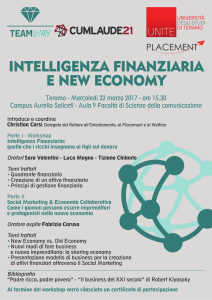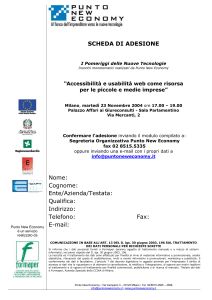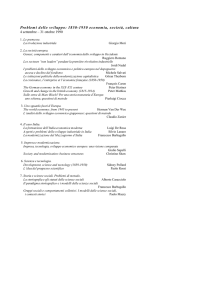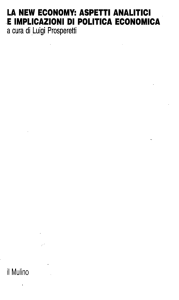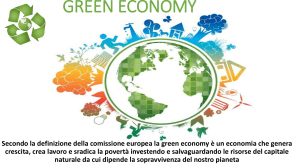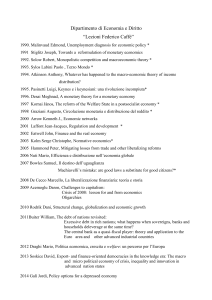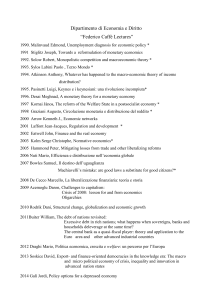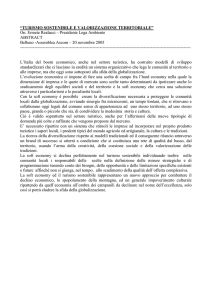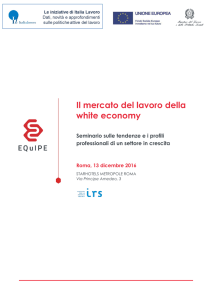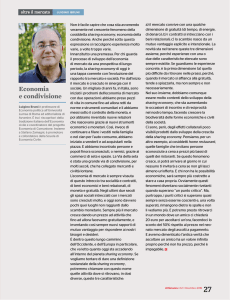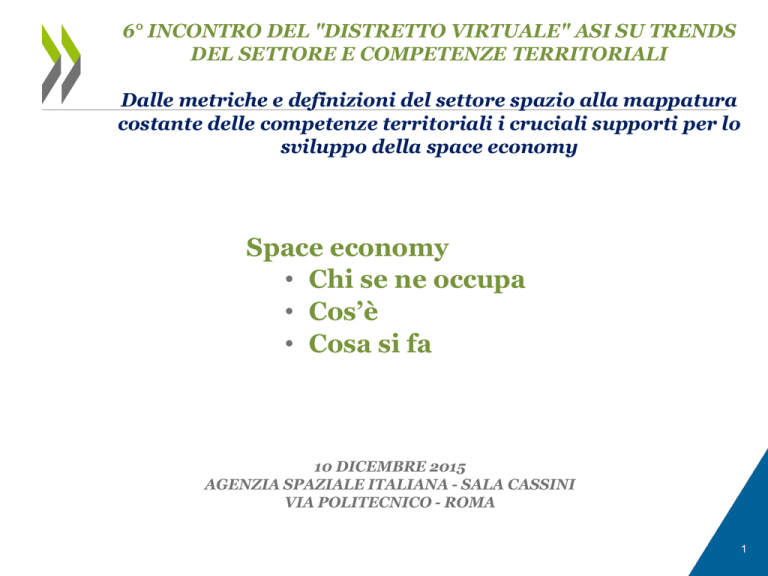
6° INCONTRO DEL "DISTRETTO VIRTUALE" ASI SU TRENDS
DEL SETTORE E COMPETENZE TERRITORIALI
Dalle metriche e definizioni del settore spazio alla mappatura
costante delle competenze territoriali i cruciali supporti per lo
sviluppo della space economy
Space economy
• Chi se ne occupa
• Cos’è
• Cosa si fa
10 DICEMBRE 2015
AGENZIA SPAZIALE ITALIANA - SALA CASSINI
VIA POLITECNICO - ROMA
1
OECD Space Forum
Directorate for Science, Technology and Innovation
How space activities relate to the global economy
The OECD Space Forum aims to assist governments, space-related
agencies and the private sector to
better identify the statistical contours of the growing space sector worldwide,
while investigating the space infrastructure’s economic significance
and potential impacts for the larger economy.
Ten members:
Canada, France, Germany, Italy, Korea, Norway, Switzerland, the United
Kingdom and the United States, and the European Space Agency.
2
IAF Space Economy Technical Committee
at the International Astronautical Conference
The Space Economy Committee will, in cooperation with other interested
Committees, foster interest in the importance of building a more robust
statistical knowledge-base of the space economy.
3
IAF Space Economy Technical Committee
Next session…
•
IAC 2016 -- 26-30 September 2016, Guadalajara, Mexico
•
Session E.3.3 “Game changers in the space economy”
•
Description: This session will explore some of the major changes taking place right
now in the space economy, with a view to identifying current and potential economic
and industrial impacts on the space sector’s different value chains. Some of the
issues that could be presented in this session include:
– how new institutional and commercial actors are shaking the traditional space
industry, which took decades to develop internationally;
– new economic models that are or will be revolutionising space-related public
procurement;
– recent technological breakthroughs in many countries that are slowly but surely
impacting industrial space developments… or not (e.g. 3-D manufacturing).
– Some future-oriented papers are also welcome for this session, although not too
long-term (e.g. projections of no more than 15 years) to contribute useful facts
and trends to the current conversation on the future of the space economy.
5
6
Space economy
upstream
downstream
2012: 83%
2012: 17%
Space
economy
Space related activities
•
•
Spin offs
Trasferimenti
tecnologici
Spillover tecnologici o della
conoscenza
7
Spillover tecnologici
High tech (Studio Università di Bergamo, G.Graziola, A. Cristini)
trasferimenti di conoscenze tra aziende che avvengono al di fuori degli
scambi di mercato, ampliando quindi senza costi i capitali di conoscenze e
la produttività.
Nel periodo 1980-2011, ogni aumento dell’1% di investimenti in R&S
nell’high tech ha provocato un aumento dello 0,36% di produttività
dell’intero manifatturiero, tramite gli spillover.
Rispetto all’high tech nel suo complesso, il settore spaziale è
potenzialmente più ‘produttore’ di spillover perché
1) l’intensità della spesa in R&S (R&S/valore della produzione) è in
media circa il triplo di quella del settore high tech complessivo;
2) i valori degli indici di diversificazione tecnologica sono simili a quelli
del manifatturiero nel suo complesso. (Maggiore è il numero di aree
tecnologiche in cui un settore brevetta, più diversificata è la sua
capacità innovativa e quindi più ampi e diffusi gli spillover che può
generare).
8
Downstream e space related activities
I approccio
Downstream: prodotti, servizi, applicazioni per uso terrestre realizzati
utilizzando tecnologie/dati spaziali
1.
Definisce un ambito di attività e non necessariamente è offerto da aziende
spaziali
a. Fatturato downstream è il totale del fatturato di un’azienda (spaziale)
b. Fatturato downstream è una parte del fatturato di un’azienda (che
produce anche altri prodotti/servizi)
2.
Componente dei costi per tecnologie spaziali > 20% del costo totale di
produzione
Space related activities delimitano attività produttive di aziende non
definibili spaziali (1b), anche se inglobano nei loro processi produttivi - in
qualche misura – tecnologie spaziali (<20%)
9
Linking perimeters with activities / products /
services
Space technology /
product / service
Specific to the space sector –
astronomy research, satellite, subsystem, …
Space-enabled product
/ service
Which WOULD not function without
satellite capacity
Activities / products /
services utilising space
technology
e.g. ad-hoc spin-offs, technology
transfers to non-space sectors…
OCSE
10
Linking perimeters with activities,
products and services
• Upstream sector
From research to space manufacturing and ground systems
(fundamental and applied research activities; scientific and
engineering support activities; material and components supply;
manufacturing of space equipment, subsystems, systems; and
telemetry, tracking and command stations).
• Downstream sector
(utilisation for terrestrial uses)
From space operations to products and services that rely on
satellite technology / signal / data to function: e.g. satellite
broadcasting (sky, car sharing, … componente costi spazio
anche <20%)
• “Space-related” activities
Products / services that may include spin-offs, or technology
transfers from the space sector (smartphone con localizzatore)
11
Come cambiano le proporzioni
Tabella 1 Produzione Upstream e downstream (M€): 2012
Produzione Unità/Aziende
Upstream
M€
Large (4)
Medium (11)
Small (22)
Micro (19)
SME (52)
TOTAL (56)
Downstream
M€
%
1,091.4
178.6
51.4
5.2
235.3
1,326.7
86.2
68.1
78.8
69.3
70.2
82.9
Solo OT
%
174.0
83.7
13.9
2.3
99.9
273.9
13.8
31.9
21.2
30.7
29.8
17.1
1,600.6 Ml Euro
Fonte: Distretto Virtuale ASI, G.Graziola
2013 Sky Italia
ricavi Euro 3.493,00
Car sharing Enjoy e Car2Go
TLC:
Sky logic
Teleport
….
Assicurazioni
…
12
Ratio Downstream / Upstream: UK, Norway, Canada, World 1997-2011
Source: G. Graziola
13
Studio produttività degli investimenti pubblici nella
scienza - conoscenza
IAC 2015
The knowledge produced by scientific space missions
A first economic analysis, focused on Italian missions in the field of
astrophysics of high-energy and particles
9 Missioni
Analisi bibliometrica
Analisi economica - produttività
14
Publications with Italian affiliation
Key
a=b + e + f + g + h or a = c + d + e + f + g + h
Mission
(e)
(f)
Refereed
No refereed
(c )
(d)
Proceedings
With number of With number of & Refereed proceedings
(b) citations ≥
citations < Articles non & articles
Total of every annual of every annual
non
Wos
refereed
average
average
SCOPUS
Refereed articles in WoS-SCOPUS
Year of Year of first
(a)
launch publication
Space Agencies
(g)
(h)
GCN
A.Tel
Y. Cat Proposal
Arxiv
Beppo SAX
XMM
Integral
Swift
Agile
Fermi
NuSTAR
ASI, NIVR
ESA
ESA-ASI,NASA , ROSCOSMOS
NASA, ASI, UKSA
ASI
NASA,ASI, CNES, JAXA e SNSB
NASA, ASI
1996
1999
2002
2004
2007
2008
2012
1984
1990
1991
1999
1999
1996
2004
1644 784
2579 1428
887 359
1091 369
640 167
955 326
147 31
249
797
151
247
72
200
29
535
631
208
122
95
126
2
41
32
7
3
39
8
0
636
725
229
151
281
321
112
132
110
232
564
171
220
0
51
284
60
4
12
80
4
Pamela
AMS
ASI, ROSCOSMOS
NASA, ASI and others
2006
2011
1995
1995
341
363
27
23
118
106
39
34
148
150
0
0
9
50
a=b+e+f+g+h
b=c+d
145
129
c = articles that, year by year, have achieved (from the date
of the first publication to 31/12/2014) a number of citations ≥
than the ‘annual average citations’ of articles published in
the same year, in the area A&A
(b)
Refereed articles in WoS-SCOPUS
( c)
With
With
With
With
Refereed
number of number of number of number of
citations ≥ citations ≥ citations < citations < Proceedings &
of every
of every of every of every Refereed Articles
annual
annual
annual
annual
nonWoS SCOPUS
everage
everage average average
(a)
Total publications
Mission
Space
Agencies
Year of Year of first
launch publication
Beppo SAX
ASI, NIVR
1996
1984
AGILE
ASI
2007
1999
(a1)
(b1)
(a2)
(b2)
(c1)
(c2)
with
with
total
total
with
total
italian
italian
italian
affiliation
affiliation
affiliation
1644
2647
784
1196
249
392
61,3%
65,6%
c1/b1 = 32,5%
c2/b2= 33,7%
640
69%
929
167
64%
251
c1/b1= 43%
XMM
Integral
ESA-ASI
1999
ESA-ASI,NASA 2002
ROSCOSMOS
1984
(*) 2002
2579
27,0%
832
33,4%
9582
2488
NASA, ASI,
UKSA
2004
1999
1091
54,0%
2021
351
36,9%
151
951
369
28,0%
1319
Nustar
ASI,
ROSCOSMOS
NASA, ASI
2006
2012
1995
2004
341
33,2%
147
24,7%
1024
604
631
No refereed
proceedings &
articles non
refereed
GCN, A.Tel., Ycat
Proposal /ArXiv
(f2)
total
(g2)
total
49
(g1)
with
italian
affiliation
1094
132
155
(h1)
with
italian
affiliation
51
9
10
281
373
171
211
2453
32
200
725
1080
110
200
554
7
15
229
971
823
122
496
3
25
151
305
118
288
39
53
2
52
0
0
(d2)
total
Research
Mission
Area
Astronomy
(h2)
with
&
total
Astrophysics italian total
affiliation
153
22,86
33,20
34,00
12
84
14,06
22,20
20,70
2609
424
284
2816
21,75
35,00
29,50
382
231
506
60
60
19,53
31,10
27,60
314
564
977
4
64
17,62
43,80
33,00
148
284
0
0
9
80
15,41
38,30
38,20
112
356
0
17
4
91
3,71
16,60
9,70
c2/b2=40,1%
247
c2/b2=62%
27
31
21,4%
29
c1/b1=93%
148
(h)
c2/b2=51,5%
145
593
24,4%
c1/b1= 18,6%
140
95
(g)
(f1)
with
italian
affiliation
636
103
(e2)
total
804
(e1)
with
italian
affiliation
41
(d1)
with
italian
affiliation
535
Average Citations from the Year
of first Wos-Scopus article after
launch to 31 December 2014
(f)
c2/b2=39,5%
797
c1/b1= 66,9%
Pamela
72
1428
5062
28,0%
c1/b1=55,8%
c1/b1=43%
Swift
(e)
(d)
c2/b2=51%
88
c2/b2=62,9%
a1= b1 + e1 + f1 + g1 or a1 = c1 + d1 + e1 + f1 + g1
a2= b2 + e2 + f2 + g2 or a2 = c2 + d2 + e2 + f2 + g2
Il valore economico della scienza
•
•
•
•
Vale la pena finanziare le missioni scientifiche?
la conoscenza è un bene pubblico
L’output che misuriamo: numero e importanza delle pubblicazioni
Non è facile usare l’analisi costi-benefici in questo caso perché non esiste
un chiaro legame tra la misura dell’output e le possibili tecnologie
alternative per ottenerle.
Una valutazione ex-post della missione spaziale può essere ottenuta
attraverso il calcolo di un indice di produttività dato dal rapporto
tra output e costo della missione.
17
Calcolo di un benchmark:
indice di produttività globale
Budget di scienza ed esplorazione dei 10 maggiori paesi
spaziali nel periodo
Numero di articoli in Astronomia e Astrofisica degli stessi
paesi nello stesso periodo
indice di produttività globale =
Articoli publicati in Astronomia e Astrofisica/Budget in
scienza ed esplorazione spaziale:
79,520 articoli/22,545,096,067 € =
= 3.527×10-6 articoli per Euro
= 3.527 articles for 1 milione di Euro
Indici di produttività di alcune missioni
Per fare un confronto con il benchmark, si considerano solo gli articoli pubblicati nel database
WoS
mission
Year of first WosScopus article after
launch
Nazionale
Indice di
efficienza
(B/C)
Internazionale
Indice di
efficienza
(B/C)
benchmark indice di efficienza
Beppo SAX
XMM
Integral
Swift
Agile
Fermi
NuSTAR
1997
1999
2002
2004
2007
2008
2013
24,74
34,49
Pamela
AMS
2006
2011
4,49
3,76
3,62
1,36
5,22
3,11
0,77
Verde: indice di produttività > del
benchmark
le risorse sono
state usate in più efficiente che nel
settore A&A complessivo globale
1. A livello nazionale sono tutti
verdi
2. Agile
3. A livello internazionale
- solo SWIFT e XMM verde
- NuSTAR valore non stabilizzato
(lancio nel 2013)
- Forte differenza dei valori degli
indici nazionale e internazionale
NuSTAR
Beppo SAX e Swift
AGILE e Fermi: due missioni con obiettivi simili provenienti da due diverse
comunità scientifiche
• Entrambe si basano sulle competenze acquisite attraverso PAMELA
XMM : missione europea (classificazione NASA: Medium-Class missions
Ma i risultati sono confrontabili con quelli di una big NASA space
missions.
Le competenze acquisite con XMM hanno permesso alla comunità
scientifica e a quella industriale di sviluppare la missione Swift
Le missioni scientifiche sono strettamente collegate, una poggia sui risultati e le
competenze acquisite con la precedente.
Senza investire in grandi missioni che rendono possibile l’acquisizione di
importanti competenze - che se implicano costi sostenuti - non sarebbe possibile
partecipare a quelle piccole che sono spesso molto redditizie e cioè con indici di
produttività alti.
Conclusioni
Space economy
• Chi se ne occupa
• Cos’è
• Cosa si fa
21

